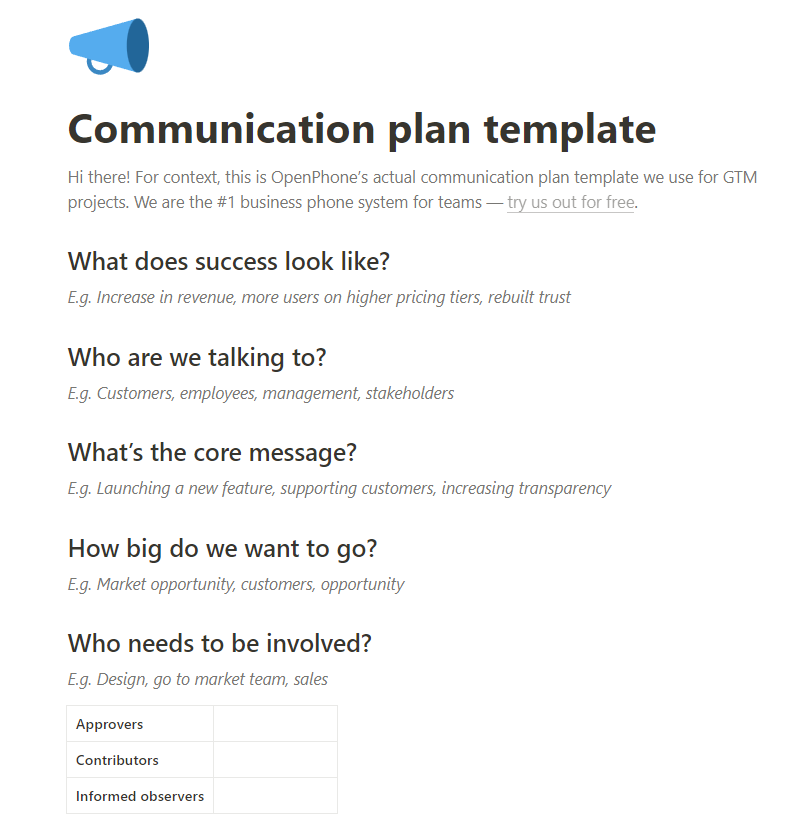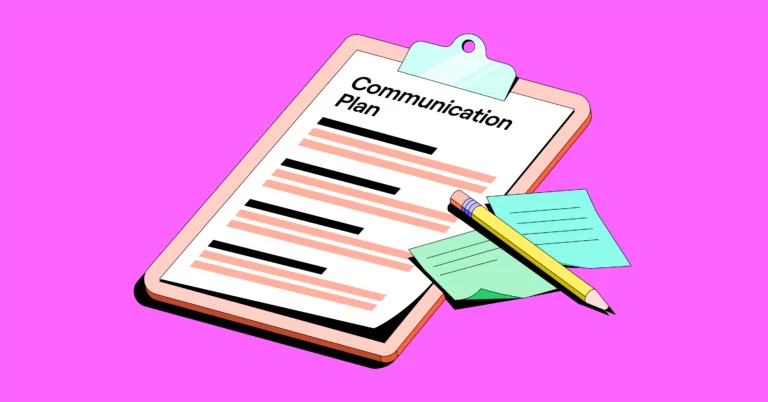An effective communication plan lays the foundation for your success in any job to be done — saving you time, money, and endless revisions. But that’s not all. It’ll also:
- Prevent last-minute mistakes: No rushing to enable an internal team or an important stakeholder the day before a project ships.
- Ensure cross-functional alignment: Reduce misunderstandings and enhance collaboration.
- Minimize project delays: Decrease the need for extensive revisions, keeping projects on track.
- Control scope creep: Maintain project focus to keep things on time and within budget.
To help you craft your own communication plan, we talked to George Williams, OpenPhone’s Product Marketing Lead, on how he forms communication plans for product launches. We also interviewed Jordan Simas, OpenPhone’s Senior Product Manager, to learn how he created a communication plan for our Series B announcement.
Let’s get started.
What is a communication plan?
A communication plan is a shared document an organization uses to lay out the goals, target audiences, and strategic initiatives behind a plan of action. It can help you launch a new product or feature, handle a crisis, roll out a new initiative or campaign, announce milestones, and more.
7 steps for writing a communications plan
While creating a communication plan from scratch may seem like an overwhelming task, it’s more manageable with a framework.

Follow these seven steps to develop an effective plan, and download our communication plan template to fill out as you read.
1. Specify goals
Your goals will differ based on the larger marketing initiative, but it’s important to have a high-level measure of success.
For example, If you’re releasing an innovative feature, George mentions you may be focused on new user acquisition and awareness, while a more table-stakes feature may be aimed at deepening engagement with existing users.
On the other hand, you may be dealing with a PR crisis — an event that could damage your brand image. In this case, your goals might be increasing transparency, rebuilding trust with customers, and being quick to respond on social media.
Pro Tip: Since responding to a PR crisis requires a proactive approach, Ashley Levesque, VP of Communications at Banzai, recommends asking:
- Is our brand’s reputation at risk with stakeholders, employees, customers, prospects, and other industry players?
- How will this event affect our bottom line?
- Will this event critically impact my company’s operations?
“If you’ve identified that the experience is indeed a crisis, then your communication goals need to reflect control over the narrative as much as possible,” Ashley says. Your communication plan should include:
- Draft messaging
- An organized checklist and timeline of steps
- Contact details for key people
“Each crisis will warrant a different communication plan, and thus different goals, but if the focus remains on getting organized and getting control over the narrative, these preliminary questions are great places to start,” Ashley explains.
Whether managing a crisis or announcing a new feature, make sure your goal is clear, defined, and measurable.
2. Identify the target audience
Nail down who you are trying to reach early in the process. This will help you create a hyper-specific and actionable communication plan.
Your target audience could be:
- New customers
- Existing users
- Employees
- Management
- Stakeholders
For example, when writing a blog post at OpenPhone, we first identify our ideal customer profile (ICP) — making it easier to craft a personalized message. Whether our audience is investors or current users, we can address their specific pain points and provide helpful solutions.
It may not always be possible to pinpoint an exact persona, but narrowing it down helps you understand how to tell the story in a way that matters.
3. Write the core message
With the foundation in place, it’s time to come up with the story behind the campaign. Ask yourself questions like:
- What aspects of the product do I want to highlight?
- Why does this matter to our customers or audience?
- How will it benefit them?
For example, after aligning with OpenPhone’s founders about the messaging for the Series B announcement, Jordan created a central document that all collaborators could reference.
Documenting your core message prevents confusion and multiple edits. “Revisions push things out and become necessary when ideas are poorly or vaguely communicated. Dial in the messaging, and the rest will follow,” says Jordan.
“As long as everyone internally gets it, everyone externally should as well. You want to optimize for the least amount of misunderstanding essentially everywhere.”
Jordan Simas, Senior Product Manager at OpenPhone
Getting internal stakeholders to weigh in on your messaging has an added advantage. “As long as everyone internally gets it, everyone externally should as well. You want to optimize for the least amount of misunderstanding essentially everywhere,” Jordan explains.
George suggests coming up with a few ideas for messaging and then narrowing your list down based on customer input:
“To validate our messaging and make sure it resonates, I’ll turn to sales or customer-facing teams or conduct customer interviews. The process is to go out, talk to people, and see what they find the most compelling about what we’re launching. Sometimes we’ll have a list of five ideas for messaging that we’ll narrow down to three after reviews.”
💡 Want an easier way to talk to your team and customers?
OpenPhone is a virtual phone system with team collaboration features that help you communicate with customers and share conversations with team members seamlessly. If you need to loop in teammates outside of OpenPhone, you can even automatically forward any text or voice messages into Slack and other platforms.
4. Set the scope
Before you dive into the operations, understand what you’re communicating and what you hope to accomplish. Defining the scope helps you deploy the best tactics and resources while preventing scope creep.
In the case of product launches, for example, George advises, “First evaluate the size and scope of the launch based on its impact on customers, as well as whether it’s an innovative or table stakes feature that’s new to the market.”
To define your scope clearly, he recommends keeping the customer, market, and best channels top of mind every step of the way. Once you know how big you want (or need) to go, you can come up with goals and identify key contributors and approvers.
Want to get started on your project doc? Download our communication plan template.
5. Rally your team
Early in the process, align with your key collaborators on who’s doing what to make your project a success.
Internal folks may include:
- Engineering
- Design
- Sales
- Go-to-market (GTM) team
- And others!
Since you may have a tough time drumming up team-wide enthusiasm for every initiative, Jordan suggests focusing on alignment instead.
“‘Excited’ is one way to get them motivated to do the work, but ‘accountable’ is the more realistic way. Assigning ownership to specific tasks as early as possible is a way to keep people accountable. Your team should be excited for customers and emphasize the value of what you’re doing,” says Jordan.
From there, make a checklist of what needs to be done and who is responsible for each task. Then, methodically track progress and remind people about deadlines.The final outcome relies on each individual component.
Pro tip: While it’s natural to have more meetings at the beginning and end of the project, you can expect to work asynchronously while your team is creating their collateral.
Some async tools that can help you work asynchronously include:
- Notion: A note-taking and collaboration tool
- Slack: A messaging platform
- Todoist: A list-making app
- Figma: A collaborative design and prototyping tool
- Slite: A team documentation and knowledge-sharing platform
- Loom: A video messaging and recording tool
6. Decide how to distribute
Determine which channels you’ll use to get your message and marketing collateral to your target audience. Your assets may include:
- Press Releases: For formal announcements and official statements
- Blog Posts: To provide in-depth information, share insights, and establish thought leadership
- Social Media Posts: For engaging with a broader online community and fostering discussions
- Videos: To convey visual and engaging content — suitable for tutorials, demonstrations, and storytelling
- Emails: For personalized communication, newsletters, updates, and direct engagement with subscribers
- Webinars: For hosting live events, training sessions, and interactive discussions with your audience
- Podcasts: To deliver audio content, interviews, discussions, and industry insights
In many cases, a combination of channels can amplify the impact of your message. That said, it’s better to focus on two or three channels and execute them to the best of your team’s abilities than to try to be everywhere at once.
Depending on your audience, you might reach out in the following ways:
- Employees — internal communication tools such as email, Slack, or phone messages
- New and existing customers — social media, blog, videos, email, or texts via OpenPhone
- Stakeholders — meetings, emails, or reports
Pro tip: OpenPhone users can use shared numbers (like a shared inbox, but for a phone) to spread the word about product updates or new initiatives and work as a team to respond to customers in a timely manner.
7. Measure the results
After you’ve shipped the campaign, it’s time to revisit your key performance indicators (KPIs), analyzing what worked and what didn’t.
“Did you drive an increase in adoption or usage or upsells? Whatever your goal is, make sure you’re coming full circle and analyzing results so you can improve next time,” George recommends.
Also, it’s a good idea to keep track of both long- and short-term results. The short-term results illustrate initial response and adoption, while the long-term ones reveal sustained impact and trends.
George explains, “After a launch, you’ll see a big bump in engagement on the specific feature — which is a good indicator of the audience you’re reaching, but for the longer term, ask:
- Does the user continue to use it? (if that’s how the feature works)
- Do they keep it on? (if it’s something that you turn on)
- Do they refer new users or customers to the feature or product?
“Ongoing engagement is key — you want to make sure it’s getting adopted and has ongoing value.”
Beyond the analytics dashboard, getting real-time feedback is a great way to improve your communication strategy. You can get feedback by monitoring customer reviews and getting input from your employees, stakeholders, and target audience to gauge how well your campaign hit the mark.
Keep in mind that a communication plan is an iterative process. After analyzing your results, incorporate the insights into future projects. This continuous feedback loop is a powerful tool for refining and improving your communication strategy.
Communicate better with OpenPhone
An effective communication plan gets you on the same page with your team members, stakeholders, and potential customers. When executed well, it sets your project up for success and prevents delays and revisions with collaborators. It can also be a reference point to see which strategies performed better than others. We call that a win win win.
Whether you’re getting feedback on messaging via customers or collaborating with stakeholders, OpenPhone makes it easier for your team to communicate faster and more efficiently, thanks to auto-replies and snippets, shared numbers, group calling, and warm transfers.
Start your seven-day free trial of OpenPhone now to see how it can help your team, and download our communication plan template to start planning your next big initiative.

